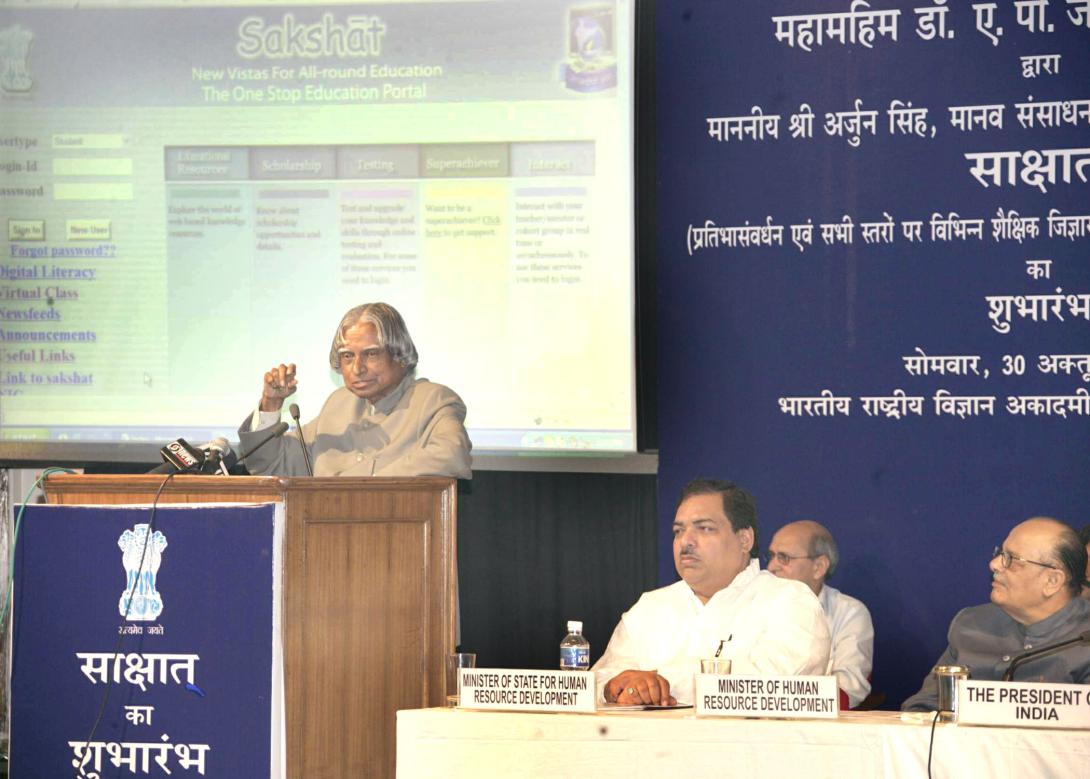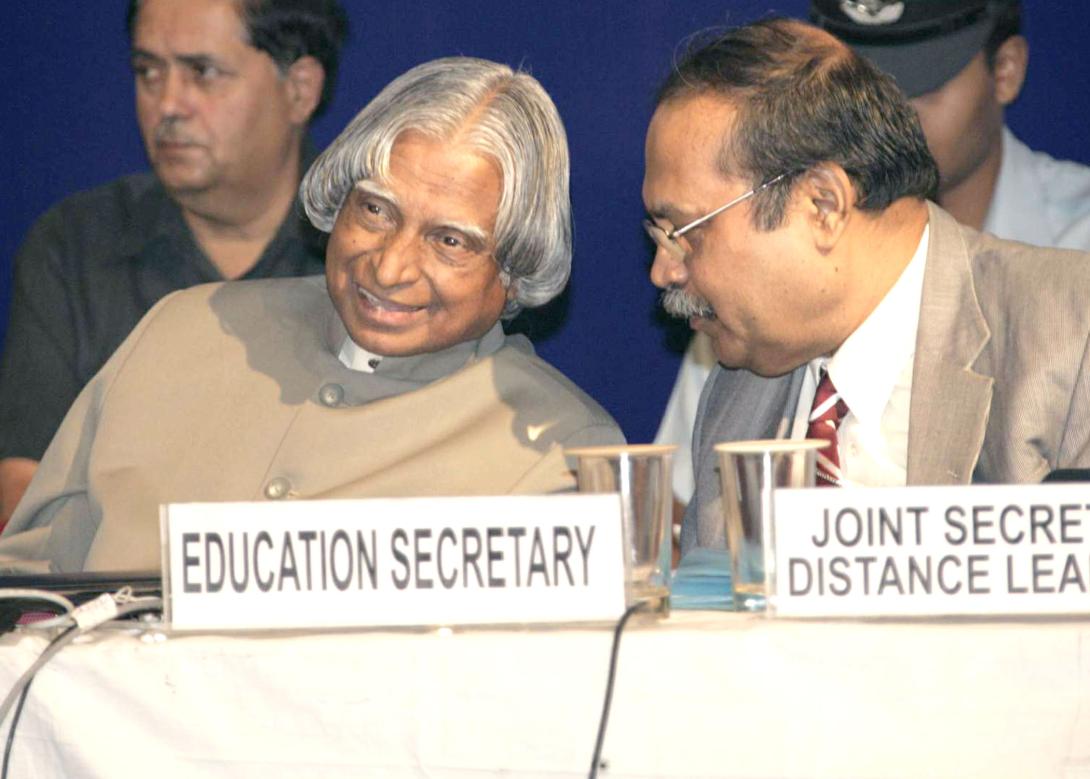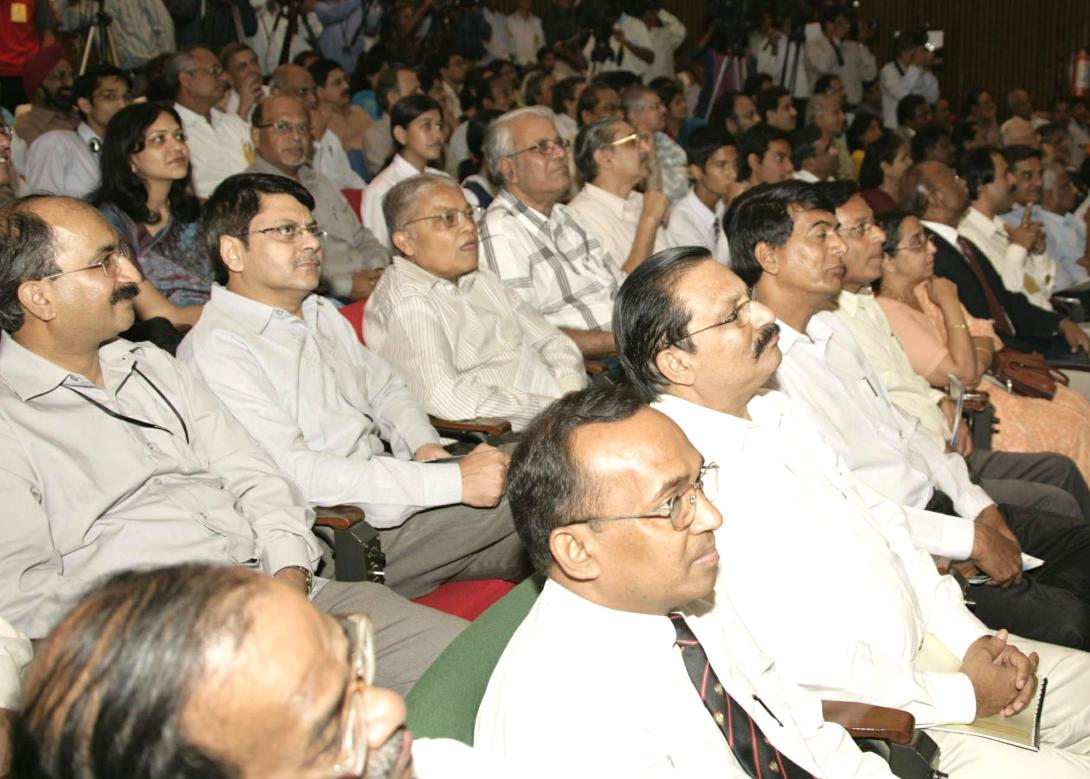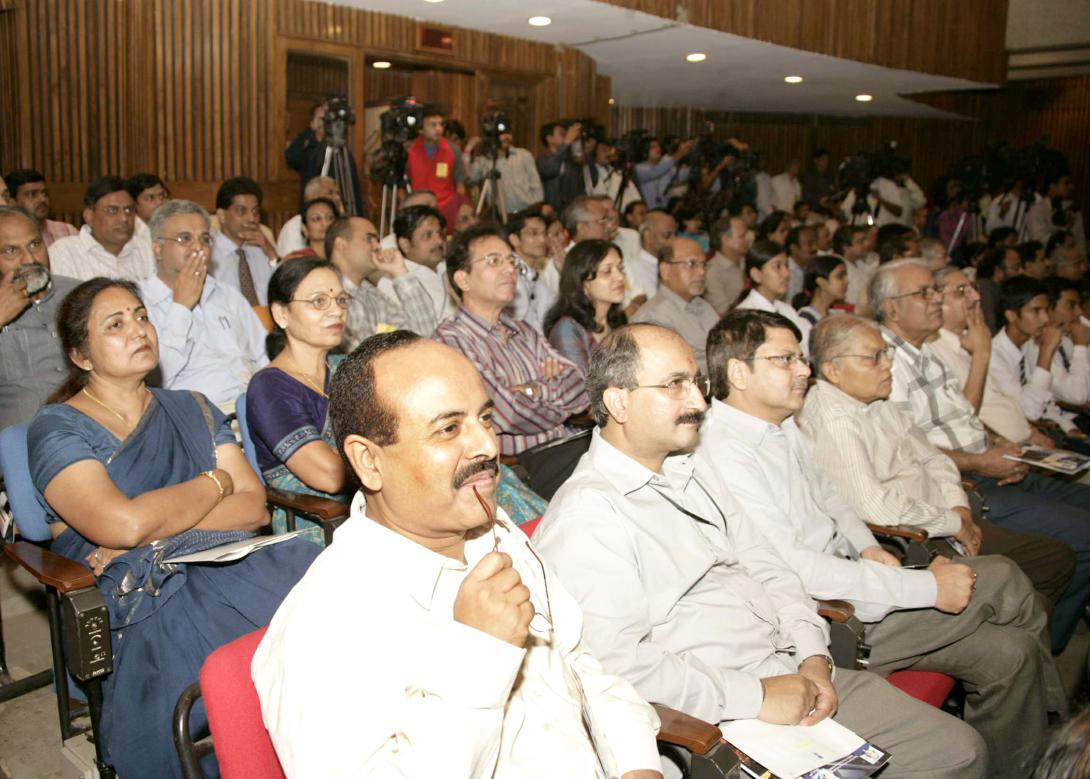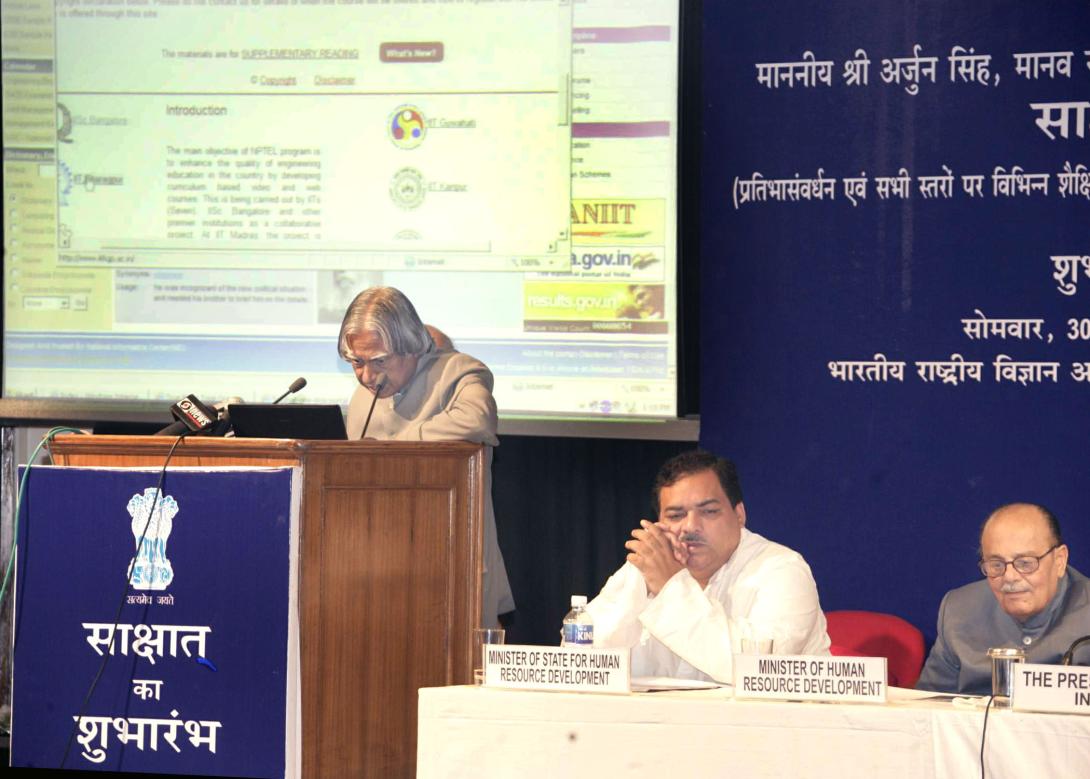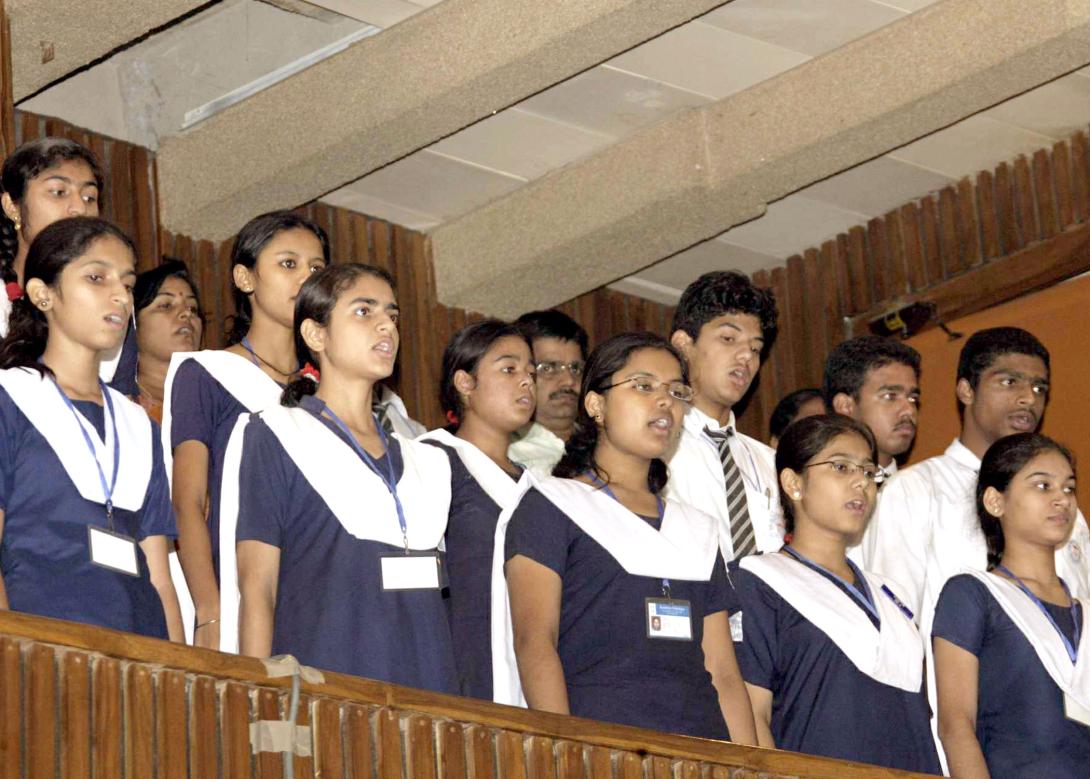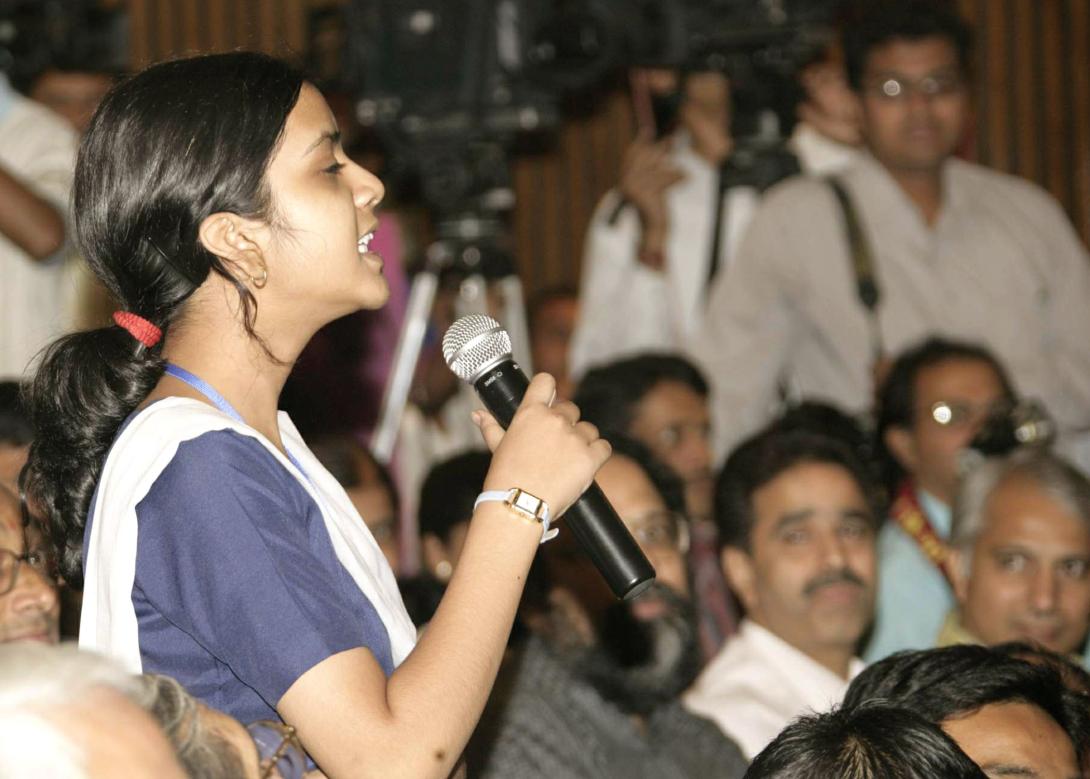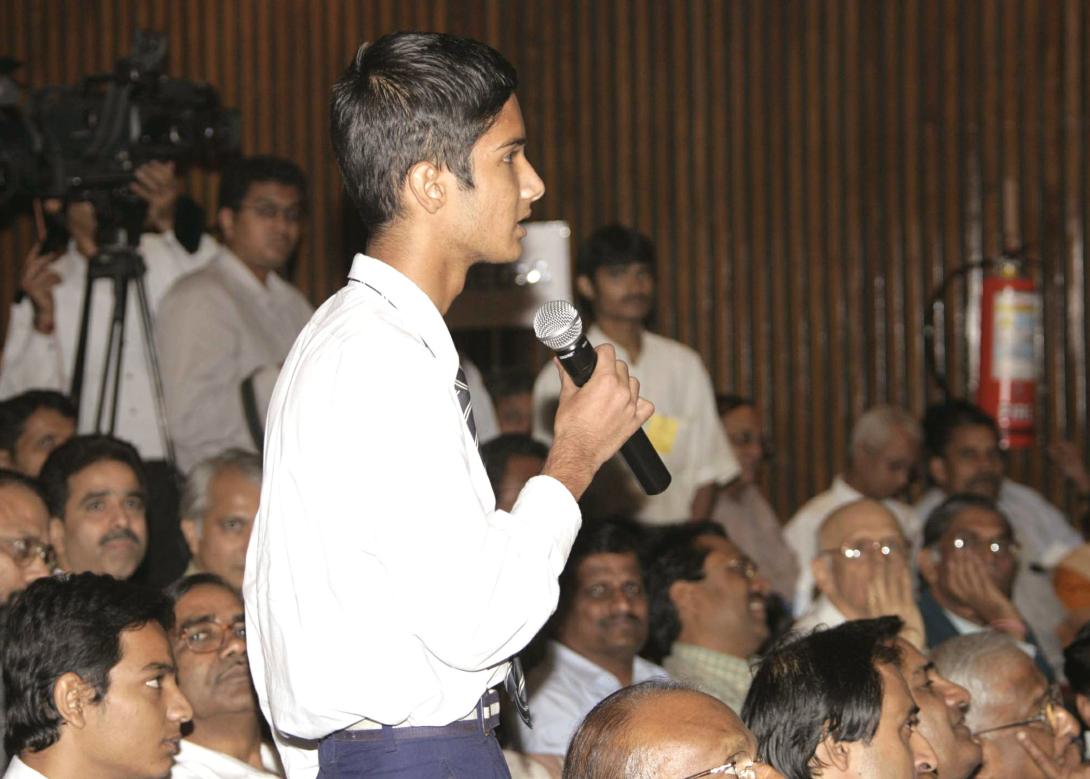Address at the Inauguration of Sakshat: One Stop Education Portal, New Delhi
New Delhi : 30-10-2006
Dynamics of Education System
Learning gives creativity
Creativity leads to thinking
Thinking provides knowledge
Knowledge makes you great.
I am delighted to inaugurate the SAKSHAT: One Stop Education Portal developed by the Ministry of Human Resource Development with their partners. My greetings to the designers of the portal from multiple institutions, organizers, students and participants. Just now I launched and used the portal as you have all seen. When I was working with SAKSHAT: portal I realized that a number of good features have been incorporated for interactive learning and self learning by the higher secondary students. I am sure these features will be extended to all the subjects in all the classes in multiple languages.
Now I would like to share few thoughts on the topic "Dynamics of Education System". As profile of the education is continuously changing: in primary school, creativity being the focus, in the secondary school, preparing the students for selecting their future courses including science being the aim and in college and university education generating researchers and mostly generating professional entrepreneurs.
Role of Education in Societal transformation
The whole purpose of education in a country is to develop and enhance the potential of our human resources and progressively transform it into a knowledge society. The knowledge society will be a society producing products and services that are rich in both explicit and tacit knowledge, thus creating value added products. The real capital of this knowledge society will be its knowledge workers. The society will be highly networked to create knowledge intensive environment along with enabling process to efficiently create, share, use and protect knowledge. Our education system should re-align itself at the earliest to meet the needs of the present day challenges and be fully geared to participate in the societal transformation. SAKSHAT is a step forward in this direction. Knowledge Society enriches information society through innovation. Information society enriches agriculture and manufacturing through value addition. Thus societal transformation is enabled by economic growth and knowledge society.
Changing Pattern of Society
When the world was moving from the industrial to information and knowledge era, we witnessed a changing pattern in the sectoral share of GDP and the number of people employed in each sector. The sectoral share of Gross Domestic Product (GDP) percentage has undergone a considerable change. Contribution of agriculture to India's GDP has reduced from 39% to 22% during the period 1979 to 2005. During the same period contribution of manufacturing sector has moved from 24% to 27% and whereas the contribution from the services sector has increased from 37% to 51%. There has been considerable change in the employment pattern also. The percentage of people employed in agriculture has come down from 64% to 54%. Simultaneously, the percentage of people employed in manufacturing has gone up from 15% to 19% and in the service sector from 20% to 27%. This trend has to continue and by 2020 our employment pattern should aim at 44% in agriculture, 21% in manufacturing and 35% in service sectors. Of course, manpower reduction in agriculture has to be met with increased technological input.
The displacement of 10% people from agriculture sector has to be facilitated through skill enabling for undertaking value added tasks in the rural enterprises so that migration to urban area is reduced. Instead of persons from the rural areas going to urban towns in search of jobs in manufacturing and services sectors, PURA (Providing Urban Amenities in Rural Areas) facilitates creation of employment in the rural areas itself. PURA achieves this by providing physical, electronic and knowledge connectivities to a cluster of villages thereby leading to their economic connectivity and prosperity. Knowledge creation and knowledge utilization is the key to the success of a PURA programme.
SAKSHAT's Growth Profile
The internet revolution has proved to be a powerful tool for good educational initiatives in the rural areas. An important dimension of the internet potential is the possibility of providing services any time anywhere. Along with this there is a conscious effort to put the youth as the centre of focus of the education system. Students should be perceived as customers and clients. E-education has to be student friendly. Delivery of services to students is to be considered as a primary function of the national mission in education. Particularly for billion plus people spread across length and breadth of the nation, e-learning should enable seamless access to knowledge and seamless flow of knowledge among institutions, specialists and the needy students. I visualize the SAKSHAT: One Stop Education Portal will grow to provide this type of seamless flow of knowledge among our youth spread over six hundred thousand villages. It is planned to have about seven thousand PURAs, which is the connected environment having physical, electronic, knowledge connectivity leading to economic connectivity.
Characteristics of the Knowledge economy
I was studying different dimensions of knowledge society and how will it be different from the industrial Economy. In the knowledge economy the objective of a society changes from fulfilling the basic needs of all round development to empowerment. The education system instead of going by text book teaching will be promoted by creative, interactive self learning - formal and informal with focus on values, merit and quality. I am sure; SAKSHAT will be able to provide this type of support to the students. The workers instead of being skilled or semi-skilled will be knowledgeable, self empowered and flexibly skilled. The type of work instead of being structured and hardware driven will be less structured and software driven. Management style will be delegative rather than being directive. Impact on environment and ecology will be strikingly less compared to industrial economy. Finally, the economy will be knowledge driven.
Global Human Resources Cadre
Presently our university education system is contributing 3 million graduates and post graduates every year and the students seeking employment after completion of 10th class and 10+2 class are around 7 million per year. Thus nearly 10 million youth are injected into the employment market every year. In the 21st century, India needs large number of talented youth with higher education for the task of knowledge acquisition, knowledge imparting, knowledge creation and knowledge sharing. At present India has five hundred and forty million youth under the age of 25 which will continuously be growing till the year 2050. Keeping this resource in mind, the Universities and educational systems should create two cadres of personnel: (1) a global cadre of skilled youth with specific knowledge of special skills (2) another global cadre of youth with higher education. These two cadres will be required not only for powering the manufacturing and services sector of India but also will be needed for fulfilling the human resource requirements of various countries. Thus, the universities and secondary school education system will have to work towards increasing the through put of the higher education system from the existing 6% to 20% by the year 2015, 30% by the year 2020 and 50% by the year 2040. The other Indians who are not covered by the higher education system should all have world class skill sets in areas such as construction, carpentry, electrical systems, repair of mechanical systems, fashion design, para-legal, para-medical, accountancy, sales and marketing, software and hardware maintenance and service, software quality assurance personals etc. No Indian youth should be without either a world class higher education or without world class skills sets. This is the mission which must be undertaken by all our Universities and the educational systems. SAKSHAT programme should think of extending the system for providing world class vocational skills to our youth for making them internationally competitive. We have to start right now to realize this goal since the overall time available for such an educational growth is short. A National Policy for creating a "Global Human Development Cadre for India" has to emerge.
Conclusion
The portal is first of its kind in India. This is of a scale not witnessed so far in the Indian Internet evolution. For this to succeed, the citizens should get free bandwidth and acquire the capability of using Internet2. Providing free bandwidth will enable free movement of molecules and atoms instead of men and material on the road. Net also creates an excellent framework for collaborative computing and collaborative development. Hence every one in the community can develop knowledge for others to consume. We become both creators and consumers of knowledge. This way it will have a sustainable and exponential growth. I would suggest all experts in the fields and teachers of India and abroad to create contents, learning modules and share their pearls of wisdom. What we are starting today by MHRD is an impressive engine with great potential to change the country and change the way education is imparted. Continuously creative feedback will enrich the portal and can bridge the gap between rich and poor, rural and urban areas and also between digital haves and have-nots. It is a mission worthy of India and Indian capabilities and prowess in ICT. It should indeed become a National Mission not only of the Government but also of the private sector, teachers, students and lifelong learners.
I wish the members of SAKSHAT: One Stop Education Portal team success in their mission of serving five hundred million Indian youth by meeting their just-in-time educational needs in a personalized manner.
May God bless you.
Question and Answer Session
1. Sir, What message will you give to a rural, poor, intelligent child who wants to reach your stature and become President of India?
- Vasanti, Class XI, Kendriya Vidyalaya, RK Puram Sector 2, New Delhi
Ans: Fix an aim. Acquire maximum knowledge to achieve the aim. Work hard. When you work towards the aim, you will definitely encounter some problem. Do not allow the problem to become your master. You become master of the problem and succeed.
2. Sir, you have a very big house of almost 350 rooms. You may be using few rooms but what are you doing with other rooms?
Ans: 315 room is an illusion. Many rooms are occupied by the President's Secretariat, Cabinet Secretariat, other departments and establishments. We have a full-fledged Multimedia studio, Information Technology Laboratory, e-Governance Data Centre, Kitchen Museum, Children's Gallery, Digital Library centre, large library and a hall to receive the children. In addition numbers of rooms are used for common State and other ceremonial functions.
3 Sir, Have you ever been depressed any of your failure like - not getting selected for pilot training.
- Mukul, Class XII, Kendriya Vidyalaya, RK Puram Sector 2, New Delhi
Ans: Initially I was definitely disappointed. Soon I found that I had been selected for a scientific job in DRDO. Later in my case I have succeeded many times and failed few times in my projects, worked hard and finally succeeded. System has tolerated such failures in our R & D work. Same is the case in many scientific and technological establishments. We should be ready to accept failures and celebrate successes and genuine efforts.
5. Sir, People think that Scientists are non-believers. But your highness has a unique blend of spiritualism and rationalism. How have you achieved that?
- Ishita, Class XII, Kendriya Vidyalaya, RK Puram Sector 2, New Delhi
Ans: The spirit of non-belief has itself belief built into it. After finding the theory of relativity, Einstein was honoured by number of people and institutions. At that time, he used to come and look at the stars in the sky. Looking at the stars in the sky he used to be surprised about the nature's creation which made him feel very humble. Thus you can see, science itself is a part of spirituality. Science provides material benefits to mankind. Whereas spirituality provides enlightenment to the mankind and enables the mankind to see the wholeness of nature.
6 Sir, when you are working for very long hours what rejuvenates your energy most? What is your stress burster?
- Bipin, Class XI, Kendriya Vidyalaya, RK Puram Sector 2, New Delhi
Ans: Interest in the task is the energy rejuvenator. Seeing the smiles on the faces of people with whom you interact is a great stress remover.

